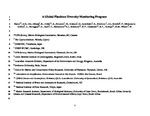A Global Plankton Diversity Monitoring Program
| dc.contributor.author | Batten, SD | |
| dc.contributor.author | Abu-Alhaija, R | |
| dc.contributor.author | Chiba, S | |
| dc.contributor.author | Edwards, Martin | |
| dc.contributor.author | Graham, G | |
| dc.contributor.author | Jyothibabu, R | |
| dc.contributor.author | Kitchener, JA | |
| dc.contributor.author | Koubbi, P | |
| dc.contributor.author | McQuatters-Gollop, A | |
| dc.contributor.author | Muxagata, E | |
| dc.contributor.author | Ostle, C | |
| dc.contributor.author | Richardson, AJ | |
| dc.contributor.author | Robinson, KV | |
| dc.contributor.author | Takahashi, KT | |
| dc.contributor.author | Verheye, HM | |
| dc.contributor.author | Wilson, W | |
| dc.date.accessioned | 2019-09-02T15:04:27Z | |
| dc.date.available | 2019-09-02T15:04:27Z | |
| dc.date.issued | 2019-06-14 | |
| dc.identifier.issn | 2296-7745 | |
| dc.identifier.issn | 2296-7745 | |
| dc.identifier.other | ARTN 321 | |
| dc.identifier.uri | http://hdl.handle.net/10026.1/14862 | |
| dc.description.abstract |
Plankton are the base of marine food webs, essential to sustaining fisheries and other marine life. Continuous Plankton Recorders (CPRs) have sampled plankton for decades in both hemispheres and several regional seas. CPR research has been integral to advancing understanding of plankton dynamics and informing policy and management decisions. We describe how the CPR can contribute to global plankton diversity monitoring, being cost-effective over large scales and providing taxonomically resolved data. At OceanObs09 an integrated network of regional CPR surveys was envisaged and in 2011 the existing surveys formed the Global Alliance of CPR Surveys (GACS). GACS first focused on strengthening the dataset by identifying and documenting CPR best practices, delivering training workshops, and developing an integrated database. This resulted in the initiation of new surveys and manuals that enable regional surveys to be standardized and integrated. GACS is not yet global, but it could be expanded into the remaining oceans; tropical and Arctic regions are a priority for survey expansion. The capacity building groundwork is done, but funding is required to implement the GACS vision of a global plankton sampling program that supports decision-making for the scientific and policy communities. A key step is an analysis to optimize the global sampling design. Further developments include expanding the CPR for multidisciplinary measurements via additional sensors, thus maximizing the ship-of-opportunity platform. For example, defining pelagic ecoregions based on plankton and ancillary data could support high seas Marine Protected Area design. Fulfillment of Aichi Target 15, the United Nation's Sustainable Development Goals, and delivering the Essential Ocean Variables and Essential Biodiversity Variables that the Global Ocean Observing System and Group on Earth Observation's Biodiversity Observation Network have, respectively, defined requires the taxonomic resolution, spatial scale and time-series data that the CPR approach provides. Synergies with global networks exploiting satellite data and other plankton sensors could be explored, realizing the Survey's capacity to validate earth observation data and to ground-truth emerging plankton observing platforms. This is required for a fully integrated ocean observing system that can understand global ocean dynamics to inform sustainable marine decision-making. | |
| dc.format.extent | 321- | |
| dc.language.iso | en | |
| dc.publisher | Frontiers Media | |
| dc.subject | Continuous Plankton Recorder | |
| dc.subject | zooplankton | |
| dc.subject | phytoplankton | |
| dc.subject | global monitoring | |
| dc.subject | biodiversity | |
| dc.subject | ocean observing | |
| dc.subject | essential ocean variables | |
| dc.title | A Global Plankton Diversity Monitoring Program | |
| dc.type | journal-article | |
| dc.type | Review | |
| dc.type | Journal | |
| plymouth.author-url | https://www.webofscience.com/api/gateway?GWVersion=2&SrcApp=PARTNER_APP&SrcAuth=LinksAMR&KeyUT=WOS:000471700500001&DestLinkType=FullRecord&DestApp=ALL_WOS&UsrCustomerID=11bb513d99f797142bcfeffcc58ea008 | |
| plymouth.issue | APR | |
| plymouth.volume | 6 | |
| plymouth.publication-status | Published online | |
| plymouth.journal | Frontiers in Marine Science | |
| dc.identifier.doi | 10.3389/fmars.2019.00321 | |
| plymouth.organisational-group | /Plymouth | |
| plymouth.organisational-group | /Plymouth/Faculty of Science and Engineering | |
| plymouth.organisational-group | /Plymouth/Faculty of Science and Engineering/School of Biological and Marine Sciences | |
| plymouth.organisational-group | /Plymouth/REF 2021 Researchers by UoA | |
| plymouth.organisational-group | /Plymouth/REF 2021 Researchers by UoA/UoA07 Earth Systems and Environmental Sciences | |
| plymouth.organisational-group | /Plymouth/Users by role | |
| plymouth.organisational-group | /Plymouth/Users by role/Academics | |
| plymouth.organisational-group | /Plymouth/Users by role/Researchers in ResearchFish submission | |
| dcterms.dateAccepted | 2019-05-28 | |
| dc.rights.embargodate | 2019-12-18 | |
| dc.identifier.eissn | 2296-7745 | |
| dc.rights.embargoperiod | Not known | |
| rioxxterms.version | Accepted Manuscript | |
| rioxxterms.versionofrecord | 10.3389/fmars.2019.00321 | |
| rioxxterms.licenseref.uri | http://www.rioxx.net/licenses/all-rights-reserved | |
| rioxxterms.licenseref.startdate | 2019-06-14 | |
| rioxxterms.type | Journal Article/Review | |
| plymouth.funder | Plankton science for supporting the implementation of marine ecosystem-based management and conservation::NERC | |
| plymouth.funder | Plankton science for supporting the implementation of marine ecosystem-based management and conservation::NERC | |
| plymouth.funder | Plankton science for supporting the implementation of marine ecosystem-based management and conservation::NERC | |
| plymouth.funder | Plankton science for supporting the implementation of marine ecosystem-based management and conservation::NERC | |
| plymouth.funder | Plankton science for supporting the implementation of marine ecosystem-based management and conservation::NERC |


